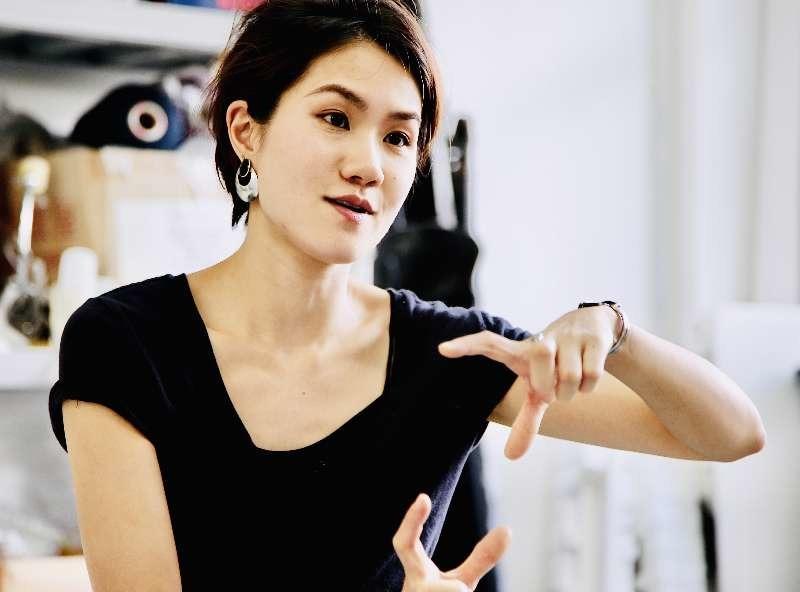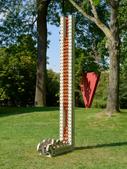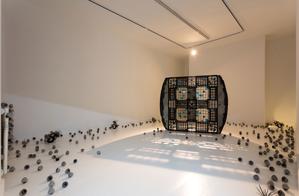LeeLee Chan won the prestigious BMW Art Journey award this year. In a freewheeling interview with China Daily, Chan shares her travel itinerary and how tracing the source and evolution of certain materials used in her sculptures might help enrich her practice. Excerpts from the interview:
 Hong Kong sculptor LeeLee Chan makes liberal use of scrap and found objects in her works. (RAYMOND CHAN / CHINA DAILY)
Hong Kong sculptor LeeLee Chan makes liberal use of scrap and found objects in her works. (RAYMOND CHAN / CHINA DAILY)
Congratulations on winning the BMW Art Journey Award 2020. Would you like to give us an idea of the itinerary you had planned?
My journey is called “Tokens from Time.” It’s planned as a research of material cultures across time and also materials themselves in their original forms. One of the places I want to go to is the Pulpí Geode in Spain.
I am interested in studying the ways in which value and desire are projected. People fetishize crystals as lifestyle products. Then there are synthetic crystals, like in a quartz watch. There are nano crystals inside our computers and phones. I think it could be interesting to be able to trace the journey of crystals as an organic form to nano crystals.
Also I want to go to certain places where ancient craftsmanship is practiced – visit marble quarries and coppersmiths in Italy, and explore silver mines in Mexico. I want to observe how material culture can transform people’s lives, even communities. For a long time since Mexico was colonized by Spain, they were making silverware aimed only at the European market. Then an American architect called William Spratling set up workshops where hundreds of silversmiths from across Mexico were encouraged to bring back pre-colonial designs, combine them with modernist ideas and create something uniquely Mexican.
I’d like to go to Japan to study pallet manufacturing, and also to a Switzerland to observe how “self-healing” concrete works. When a piece of concrete develops cracks, the bacteria inside it are made to wake up by coming in touch with water and start the repair work.
I will also go to Germany to research use of nanotechnology and its application on metal – the kind they are using to make airplanes lighter.
Is your interest in hi-tech a new thing, given your own creations so far had largely to do with objects of everyday use, brought together in a way that’s meaningful?
On this journey I wanted to do something that was out of my comfort zone. I know nothing about nanotechnology or biomaterials and wanted to find out about them.
In Hong Kong we’re so detached from the way things are made ever since most of the manufacturing activity moved to the Chinese mainland. So I wanted to go to places where ancient crafts were practiced and there was a strong sense of community around such practice. I also wanted to contrast such experiences with that of observing high technology at work.
So the journey is not so much about learning from the masters of a certain craft but just being there to observe and understand different materials. I think the point is to absorb the experience and find out how I can make some of it my own.
It’s also an opportunity for me to break my usual pattern of work and bring new elements into my practice and create more chemistry.
 The BMW Art Journey award will support Chan’s extensive travels around the world toward a research of material cultures across time. (RAYMOND CHAN / CHINA DAILY)
The BMW Art Journey award will support Chan’s extensive travels around the world toward a research of material cultures across time. (RAYMOND CHAN / CHINA DAILY)
COVID-19 must have disrupted your travel plans. Is there a Plan B in place?
I need to be flexible with the BMW Art Journey. Rather than going to all the places on my itinerary at one go, I need to do these maybe one at a time, depending on when it’s safe to go to a certain place.
One of the good things about the BMW Art Journey is that one is not obliged to produce a piece of art at the end of it. Recently Samson Young (winner of BMW Art Journey, 2015) told me he was still in the process of unpacking things he collected from his journey and using them to make new work.
Two very striking photos taken by you appear on the BMW Art Journey web page: a) a destroyed tennis court in Indian Recreation Centre and b) a recycled plastic crate dealership in Tin Shui Wai. Would you like to tell us what drew you to these images?
I shared those photos because I thought my audience might be curious about where I source my material from. Almost all of my sculptures begin with me picking up things of everyday use. For instance, the pallet in my Pallet in Repose (Marine) piece (exhibited in Capsule Shanghai, 2019) was something I found in an industrial building in Fo Tan. After I have picked up something I start imagining its possibilities and start building around it, try to connect it with other objects and create meaning in something that doesn’t seem to have any.
I think the objects in the two photographs you mentioned – a rubber surface tennis court and plastic pallets – share common features. The purpose of both is to enhance human performance. Both are mass produced and recyclable.
I am drawn to objects that have no memory associated with them, rather than things that are passed on from one person to another. I go for things that are of little value. And what could be lower in value than broken asphalt that is disposable?
What you seem to be doing in your creations though is to reject the idea of material value by investing mundane, everyday objects with personality and dignity…
We often have pre-conceived notions about objects. For me, making a sculpture is a process in discovery. When I finish working on a piece of material, I see it in a completely different light. And that process is very humbling. The point of it is to try and forget what I know about the material I started with. I am interested in the ways in which the value of a thing can change.
 Chan’s works are often marked by a tension between the natural and artificial, real and fake, thrown together in the same space. (RAYMOND CHAN / CHINA DAILY)
Chan’s works are often marked by a tension between the natural and artificial, real and fake, thrown together in the same space. (RAYMOND CHAN / CHINA DAILY)
A sense of humor comes through in many of your works, be it putting an anthropomorphic spin on used plastic pallets; or calling a rather benign-looking sculpture made primarily out of used Styrofoam packaging material Protector.
In Protector I used egg packaging material, a car windshield and mother of pearl tiles. So the original purpose of all the objects used in the sculpture is to protect things. The shape of the sculpture looks like a totem pole. It looks monumental and carved out of stone. But it’s actually Styrofoam and super light.
I don’t think the humor is intentional, but I think titles like Blindfold Receptor and Transmitter convey the idea of machines being human-like.
Because you work with so much industrial material, such names and the often robotic, mechanized look of your sculptures bring to mind sci-fi films like The Terminator…
I think I like to stir people’s imagination and also play with their expectations. For example, my Blindfold Receptor was inspired by a New York Times article which mentioned caterpillars can sense color through their skin and change their own body color to match the background. Apparently the caterpillars were blindfolded for the experiment. So I was struck by the contrast that while we human beings end up changing the environment by excessive use of technology, getting more disconnected from our bodies in the process; caterpillars have adapted to the Anthropocene environment by developing a mechanism to sense color through skin.
For the sculpture I used columns of metal frame storage racks used to hold height adjustable shelves. After I read the article, I noticed the grooved columns in my studio. When I and looked out of the window, I found a similar ethos in the high-rise public housing buildings in the distance and made a connection between these three unrelated things.
Since you use a lot of found objects in your works, does the hunt for material sometimes take you to strange, unfamiliar places, like going on a discovery trip?
I am just very open to exploring locations. Often it’s a case of the objects I use finding me. Like the destroyed tennis court image you mentioned looks like it could have been staged, but it is not so.
 Chan’s Blindfold Receptor (Gulf Frit. Orange) will remain on show in Cologne Sculpture Park, Germany, until 2022. (PHOTO PROVIDED TO CHINA DAILY)
Chan’s Blindfold Receptor (Gulf Frit. Orange) will remain on show in Cologne Sculpture Park, Germany, until 2022. (PHOTO PROVIDED TO CHINA DAILY)
I imagine there is a method to the way you collect things…
I don’t think there is. It is completely intuitive, which is not to say that everything I collect will eventually get turned into a work of art. Conversely, if I go out to look for something to work on for a forthcoming project, I usually come back without finding anything.
Do you ever feel that you are communing with the objects you work with the way people say they commune with nature?
I wouldn’t go so far as to say I have a spiritual connection with them. But I do see them as living things with distinct entities and feel there is a logic to their existence. I see everything as connected to each other.
Since you use a lot of scrap and found objects in your works, would you say just about any object is potentially a piece of art?
I think it starts with making a psychological connection with the object. When I choose something to work on, it is because I find something seductive about the material. I want the piece that emerges from it to surprise me. If I already know what it will look like that will be very boring and there won’t be much point making it. Also I think artists should embrace failure and vulnerability. I think art is about the process of making it and being open to experimenting. To me the most interesting idea comes from failure. For instance, when I was making Blindfold Receptor, I think I learnt a lot by putting myself in that vulnerable position and it allowed me to explore what was going on in my subconscious.
Do you also use natural material in your works?
I do. I used sea shells in some of my works that figured in the just-concluded Up Close – Hollywood Road show. I also used sea shells I collected in Scotland in Protector. So that sculpture is like a compression of times and places I have experienced.
Also in a piece called Endless Consumption, a tall totemic pole crafted mainly out of found polystyrene packaging, I placed a plant in front that looked like feather. I am always playing with real and fake and putting them together.
Is your fondness for using recycled packaging and building materials a reflection of your concern for the environment and sustainability issues?
As an individual I try to be responsible in my behavior towards the environment as far as I can. But I won’t call myself an environment-oriented artist trying to make art with upcycled material. For instance, I use material like concrete and resin that are not good for the environment.
But I definitely think it is important to strike a balance. For instance, instead of buying a new polystyrene or Styrofoam, I use recycled material.
I am drawn to the geometric structure of packaging material. My Endless Consumption piece, for instance, makes a reference to the Romanian sculptor Constantin Brancusi’s Endless Column. A column made out of polystyrene packaging represents the detritus of the excesses of consumer culture. So there is this interplay between high and low art, modernist sculpture and pieces of Styrofoam.
I find it interesting to use structured material to build organically. If I had the choice of using more environment-friendly material I will go for it. Maybe this is why I included the study of mycelium and other bio-technologies in my BMW Art Journey… to figure out whether some of the materials I use now could be substituted with less-polluting ones in the future.
Also, I work very slowly, everything is fixed by hand or simple machines, so my process is the opposite of hi-tech, and in a way resistant to consumer culture.
At the same time, I am also trying to reflect the society I am in. If every time I make something I have to start worrying whether the material I am using is environment-friendly, that can be very restrictive.
Also, by shipping my artwork for exhibitions overseas I am increasing my carbon footprint. So there is a tension between my personal beliefs about environmentalism and my current practice, which is why I am reluctant to call myself an artist who is also a crusader for protecting the environment.
 Chan’s work, Pallet in Repose (Marine), exhibited in Capsule Shanghai last year, anthropomorphizes recycled industrial material. (PHOTO PROVIDED TO CHINA DAILY)
Chan’s work, Pallet in Repose (Marine), exhibited in Capsule Shanghai last year, anthropomorphizes recycled industrial material. (PHOTO PROVIDED TO CHINA DAILY)
How would you say a sculptor’s vocation today is different from what it used to be in the past?
Nowadays one can buy raw material from anywhere by just ordering online. I think that impacts an artist’s practice. There are so many videos on the internet teaching people how to make things with silver, which is how I learnt some of the techniques I follow. This was not available before.
A sculptor today has endless choices. How an artist deals with this overload of choices in terms of information and materials is also very different from what my parents’ generation had to deal with.
Could being given an endless variety of things to choose from also be restrictive in certain ways?
I think when you have more choices it’s harder to be free, because to have freedom you need more head space around you.
Do you think you have the freedom to express yourself in art?
I do. I cannot imagine being an artist without having such freedom.
What made you come back to Hong Kong after so many years spent abroad? How does this help your art?
I came back primarily because my family lives here in Hong Kong. I went to art school in the United States when I was 17. I lived abroad, on my own, for 13 years. I always knew I would come back, and I wanted to do that when I was still young so that I could try my hand at doing many things.
My parents who ran an antique shop on Hollywood Road can tell if a piece is authentic just by looking at it, without having to put it through x-ray. It is like secret knowledge, passed through generations, and I wanted to inherit it from them. I think such knowledge can change my work, open up a different perspective for me.
People had told me the art scene in Hong Kong was too small, there were not that many opportunities, but that’s something I wanted to find out for myself.
And are you happy you made that decision? Is Hong Kong a suitable place for artists to work in?
One of the constraints is that of space, it’s probably not very practical for a sculptor to set up base here, the rents are high… but then artists face those same constraints everywhere. It’s never easy. I think if you want to be an artist, you will make things work for yourself.
After moving back to Hong Kong I feel very settled. When I was living in New York, it was very exciting, and eye-opening in a lot of ways… at the same time there was this feeling of uncertainty… I never knew when I might have to pack up and leave… But back in Hong Kong, I feel more relaxed because it is my home. I can put all my energy into my work. It’s being in a very different mental state compared to what it was in the US.
Interviewed by Chitralekha Basu


